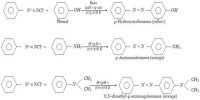In the tables of properties of methanol and ethanol the vapour pressure at 38°C has been given as this is the temperature at which RVP measurements on gasolines are performed. Returning to the information in section 3.6.1 of this book, the value for methanol is lower than any value for a gasoline given there, and the value for ethanol much lower. The methanol value might conceivably correspond to the ‘summer RVP’ for a gasoline, but the ethanol value would be most unlikely to.
This can be roughly correlated with boiling points. Gasoline boiling ranges do of course vary significantly, but 60°C is often given as the initial boiling point of a typical gasoline. The boiling point of methanol is close to this, whereas that of ethanol is well above it.
The range 0.5 to 0.75 cSt at 40°C was given for the kinematic viscosities of gasolines, and those of either alcohol are comparable to this. The acoustic impedance is also about the same for the alcohols as for gasolines. The refractive indices of the alcohols are close to each other, and that of methanol is almost indistinguishable from that of water. The alcohol values are somewhat lower than those for gasoline. Thermal conductivities are significantly higher (by almost a factor of two in the case of methanol) for the alcohols than for gasoline.
The dielectric constants are much higher for the alcohols. Those for the alcohols are a third to a half the value for water. The coefficients of expansion of the alcohols are only very slightly higher than the generic value of 0.00095 K-1 for gasolines.













